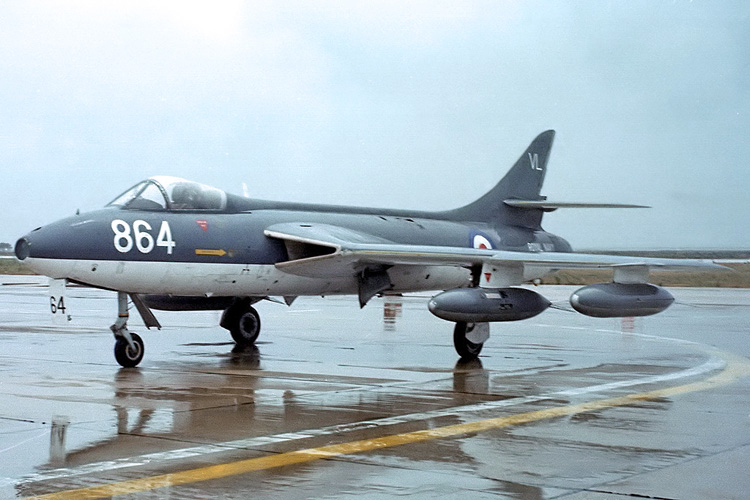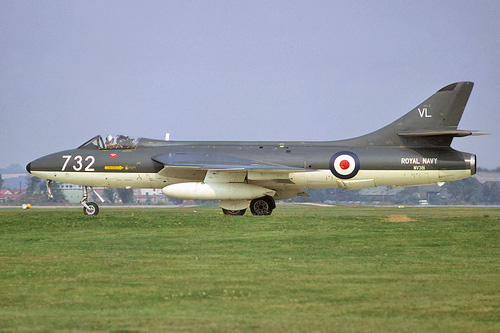
Short Feature Article by Ben Belben
I decided to build this Hunter after seeing this very aircraft at my local airfield Bruntingthorpe at the May bank holiday.
I’d purchased this kit some weeks previous to the event and being stood next to the real aircraft my mind started to think of what could be, I’d already hatched a plan of how I would convert this into the GA11 model and luckily it seemed to all work fairly well.
Here’s a bit of background on the Hawker Hunter – in case you need a steer!
The Hawker Hunter is a transonic British jet-powered fighter aircraft that was developed by Hawker Aircraft for the Royal Air Force (RAF) during the late 1940s and early 1950s. It was designed to take advantage of the newly developed Rolls-Royce Avon turbojet engine and the swept wing, and was the first jet-powered aircraft produced by Hawker to be procured by the RAF. On 7 September 1953, the modified first prototype broke the world air speed record for jet-powered aircraft, achieving a speed of 727.63 mph (1,171.01 km/h; 632.29 kn).
The single-seat Hunter was introduced to service in 1954 as a manoeuvrable day interceptor aircraft, quickly succeeding first-generation jet fighters in RAF service such as the Gloster Meteor and the de Havilland Venom. The all-weather/night fighter role was filled by the Gloster Javelin. Successively improved variants of the type were produced, adopting increasingly more capable engine models and expanding its fuel capacity amongst other modifications being implemented. Hunters were also used by two RAF display teams: the “Black Arrows”, who on one occasion looped a record-breaking 24 Hunters in formation, and later the “Blue Diamonds”, who flew 16 aircraft. The Hunter was also widely exported, serving with a total of 21 overseas air forces.
During the 1960s, following the introduction of the supersonic English Electric Lightning in the interceptor role, the Hunter transitioned to being operated as a fighter-bomber and for aerial reconnaissance missions, using dedicated variants for these purposes. Two-seat variants remained in use for training and secondary roles with the RAF and the Royal Navy until the early 1990s. Sixty years after its original introduction it was still in active service, being operated by the Lebanese Air Force until 2014.
The Hunter saw combat service in a range of conflicts with several operators, including the Suez Crisis, the Aden Emergency, the Sino-Indian War, the Indo-Pakistani War of 1965, the Indo-Pakistani War of 1971, the Rhodesian Bush War, the Second Congo War, the Six-Day War, the War of Attrition, the Yom Kippur War, and the 2007 Lebanon conflict. Overall, 1,972 Hunters were manufactured by Hawker Aircraft and its successor, Hawker Siddeley, as well as being produced under licence overseas. In British service, the Hunter was replaced in its principal roles by the Lightning, the Hawker Siddeley Harrier and the McDonnell Douglas F-4 Phantom II.

Hunter GA.11
Single-seat weapons training version for the Royal Navy. Forty ex-RAF Hunter F.4s were converted into the Hunter GA.11. The GA.11 was fitted with an arrester hook and some later had a Harley light. The guns were removed.

Reference
Here’s a useful reference on the Hawker Hunter GA.11
A note from Geoff
It’s great to be able to welcome Benjamin to SMN with his lovely build of the Academy Hawker Hunter in 1:48. Despite a few accuracy issues (wheel size, seat, jet pipe etc) you can clearly see that the Academy kit can build into a very nice model as Ben proves here – great job and glad you enjoyed the build Ben – there are so many great schemes for the Hunter, I’m not at all surprised that you bought two more! And they are very reasonable to pick up price-wise.
Here’s one pic for you to see how nicely Ben’s model turned out…
